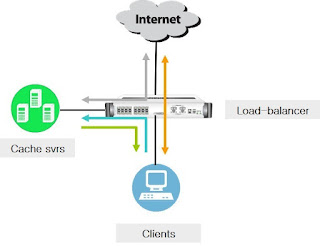This time, let's talk about the L4 switch. Let's take a closer look at what the L4 switch does and what it does.
1. what is an L4 switch?
Equipment corresponding to 4 layers of OSI 7 : Equipment that load balances incoming data.
Are you curious about what road balancing is here? Load balancing is interpreted in Korean as load balancing.
Load balancing: It is distributed and allocated so that the load is equal. There are several ways of load balancing, and we'll look at what equipment is load balancing.
1. SLB (Server Load Balancing)
2. FWLB (Firewall Load Balancing)
3. VPNLB (VPN Load Balancing)
4. Cache Server Load Balancing (CSLB) has four load balancing methods.
1) SLB (Server Load-Balancing)

A method of communicating the appropriate load balancing algorithm to multiple servers by referring to the
IP address and port number. Use virtual IP (virtual IP) addresses that represent all servers for Load Balancing.
* Introduction Background and Effectiveness
In the past, online services themselves were not active, and only the Old Site by html, image simple services were used. These days, New Site by html, cgi, SSL, and flash require complex environments, increased TCO, many associated services, and traffic management.
So, we're going to spend a lot of money on H/W such as CPU and MEMORY, but if the server goes down, the online service itself is impossible, and we're going to lose a lot of money during the failure time.
So what I came out to supplement that is SLB using the L4 switch.
For example, Auction has eight WEB servers and enables load balancing. It distributes the load across multiple servers, so even if there is a lot of traffic, the server does not stutter, and even if one or two servers go down, the remaining six servers are serviced without any problems, making it a fail-over for integrity.
: Principle of motion
- Set VIP (Virturl IP) on L4 switch
- Clients connect as VIPs
- L4 switches load balance with Rip (Real IP) of servers
- When I go back to Klein Ant, I'll be transformed into VIP.
- The L4 switch periodically checks the presence or absence of a live server through health check with the servers.
2) FWLB (Firewall Load Balancing)

How to deliver the appropriate load balancing algorithm for two firewalls.
* Introduction Background and Effectiveness
Previously, when using one firewall, the load was concentrated, resulting in poor quality of Internet services and inability to use Internet services in the event of a failure in FW.
The load balancing function of the L4 switch has enabled FWLB through two firewalls.
Increase availability and performance through load balancing of firewalls, and increase response speed through dynamic distribution. It has the advantage of easy firewall expansion and management without changing the system.
※ The key point.
FWLB requires two L4 switches. As you can see in the picture, it should be configured like this, one above, and one below, based on the firewall.
Because a session must go through only one firewall, two units must be configured as internal L4 and external L4 for session synchronization.
To put it simply, if a packet that went through the left firewall enters the right, there was no syn from the right firewall's point of view, but because the syn+ack came, it thinks it's an attack and blocks the packet, so two L4 switches are unconditionally required.
3) VPNLB (VPN Load Balancing) & CSLB (Cache Server Load Balancing)
Just like FWLB, it's the same way that FWLB delivers the appropriate load balancing algorithm for two VPNs.

* Cache Server Load Balancing
It distributes the load of the cache-oriented server, which is characterized by LB without changing the desti
nation IP due to the nature of the cache server.
- Client does not require separate settings.
- Service availability in the event of a Cache-svr failure
That's all for the four ways of load balancing. SLB & FWLB is the most popular in the field. If you go deep into the L4 switch, there's a lot of complexity, simply looking at what the L4 switch is and how it is.
There are also scheduling methods for how to reduce the load to how many units, load balancing equipment, and health check methods. Most importantly, please understand that the L4 switch plays a role, the load balancing method has a hammer, and it is roughly configured and operated in this way.
저의 글을 읽어 주셔서 감사합니다. 오늘도 즐거운 하루 보내세요.
'NETWORK' 카테고리의 다른 글
| What is an access list? (0) | 2024.05.26 |
|---|---|
| What is Stacking - Switch Stacking Technology (0) | 2024.05.23 |
| Cloud - Three Services (0) | 2024.05.19 |
| IP Address v6 - Expression, Advantages and Disadvantages (0) | 2024.05.08 |
| Understanding the Cloud, Five Features (0) | 2024.04.25 |



